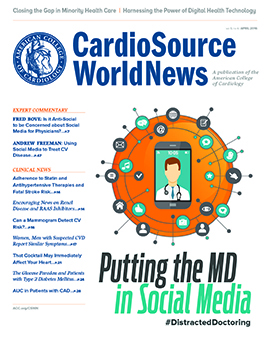Editor’s Corner: Is it Anti-Social to be Concerned About Social Media for Physicians?
CardioSource WorldNews | The evolution of communications for physicians remains a work in progress. That comment is not an age-related opinion: CSWN contributing columnist Andrew Freeman, MD, FACC, a preventive cardiologist in Denver, CO, is almost young enough to have never known a world without online access and he agrees: “We haven’t figured out how to really use this stuff yet.”
Andrew is the former chair of the ACC Fellows in Training (FIT) Section Leadership Council and the former chair of the Early Career Section and Council and he says, “The future will be when social media lets us connect with our patients directly —for now it is more of a mass communication tool and its key benefits are in provider education, news collection, and commentary as well as public health messages. While there are some platforms for more one-on-one connections, these are still not quite at the level they need to be to provide the best care.”
We’re heading in the right direction: 30 years ago, before faxing became widespread, communication consisted of telephone calls to transmit information between physicians and between physicians and patients. Back then, upon returning from my clinic at 5 PM, I would find slips of paper taped to my office door, alerting me to calls that needed answering. I dreaded the note on my door from a patient who had left a message that he was having severe chest pain and dyspnea that started an hour ago; “Please, call back.”
By now, we have trained our office personnel how to handle such a call, but those little notes on the door are still with us; they have just changed “platform” and now flood in digitally. Email started out being exchanged among physicians and support staff, then between physicians and patients. We can now use text messaging via smart phone, to provide instant mobile access to communications—or something approaching communication if you are not prolific in IM acronyms.
I Have SoMe Concerns
But one-to-one communication has another dimension that defines social media or SoMe (for a world that abbreviates everything). Social media can be defined as internet-based applications that allow the creation and exchange of user-generated content. By design, a social media network allows many users to be connected at once. For most physicians, using one of the social media tools (Twitter, Facebook, LinkedIn, YouTube, etc.), is primarily an information channel: it helps us stay-up-to-date on news that may affect our patients or tip us off to information that out patients will see and then ask us about during their next visit.
While many of us remain simply observers of social media, many physicians maintain a strong online presence, whether via blogs, Facebook posts, or a Twitter feed where they post information for others to use. (Reviewing this issue’s cover story list of Top 10 Cardiologists who are followed by other cardiologists is a good demonstration of what it means to be SoMe proficient.)
If you’re not ready for your own open, world-wide platform, using a closed social media network can be helpful. There are many “members only” social media sites that allow users with similar interests like health care or cardiology to share information in closed forums. Or you can join an established online destination. The ACC has thriving social media networks on Facebook, Twitter and LinkedIn. The JACC family of journals also has a terrific Facebook page (www.facebook.com/JACCJournals?ref=br_tf) with 45,000 “likes” and the publication you are reading right now has its own YouTube channel (www.youtube.com/user/CSWNews/featured) with more than 500 videos (most with authors of JACC papers) and closing in on 150,000 views.
One important question: how much time are physicians devoting to use of social media? As of the end of 2015, the latest data suggest that around 67% of physicians use social media in a professional context (Institute for Health Technology Transformation). Ask about broader use and 87% of physicians report regular personal use. A study from Johns Hopkins School of Medicine found one in four physicians uses social media daily—and that was 4 years ago, so one has to assume that number has grown.
While the prevailing wisdom suggests “Physician Tweet Thyself,” from my perspective, there isn’t much to gain from social media in communications between physicians or between physicians and patients, at least in terms of the day-to-day information needed to practice efficiently. Having said that, clearly some of the leaders in our field believe enough in social media to have a strong, persistent presence. And there is no doubt that patients need access to reliable health information and, fortunately, most patients still trust information from their own doctors.
Of course, if you are managing a seminar, you might use Twitter to collect real-time comments from the audience, and these could be displayed for everyone to see. Still, our first choice is usually one-on-one communication with another physician or with a patient; preferably with assurances that the message gets to the proper person and is secure. Clearly such messages should not be broadcast on a social media network.
So, we are left with email and text messaging for most of our communications. These two tools seem to provide what we need on a day-to-day basis. However, things are changing as a growing number of peers and thought leaders use SoMe tools that make email and texting look a little like my old office door; functional, but not exactly state-of-the-art.
Alfred A. Bove, MD, PhD, is professor emeritus of medicine at Temple University School of Medicine in Philadelphia, and former president of the ACC.

|
Read the full April issue of CardioSource WorldNews at ACC.org/CSWN |
Keywords: CardioSource WorldNews, Dyspnea, Public Health, Social Media, Communication
< Back to Listings
